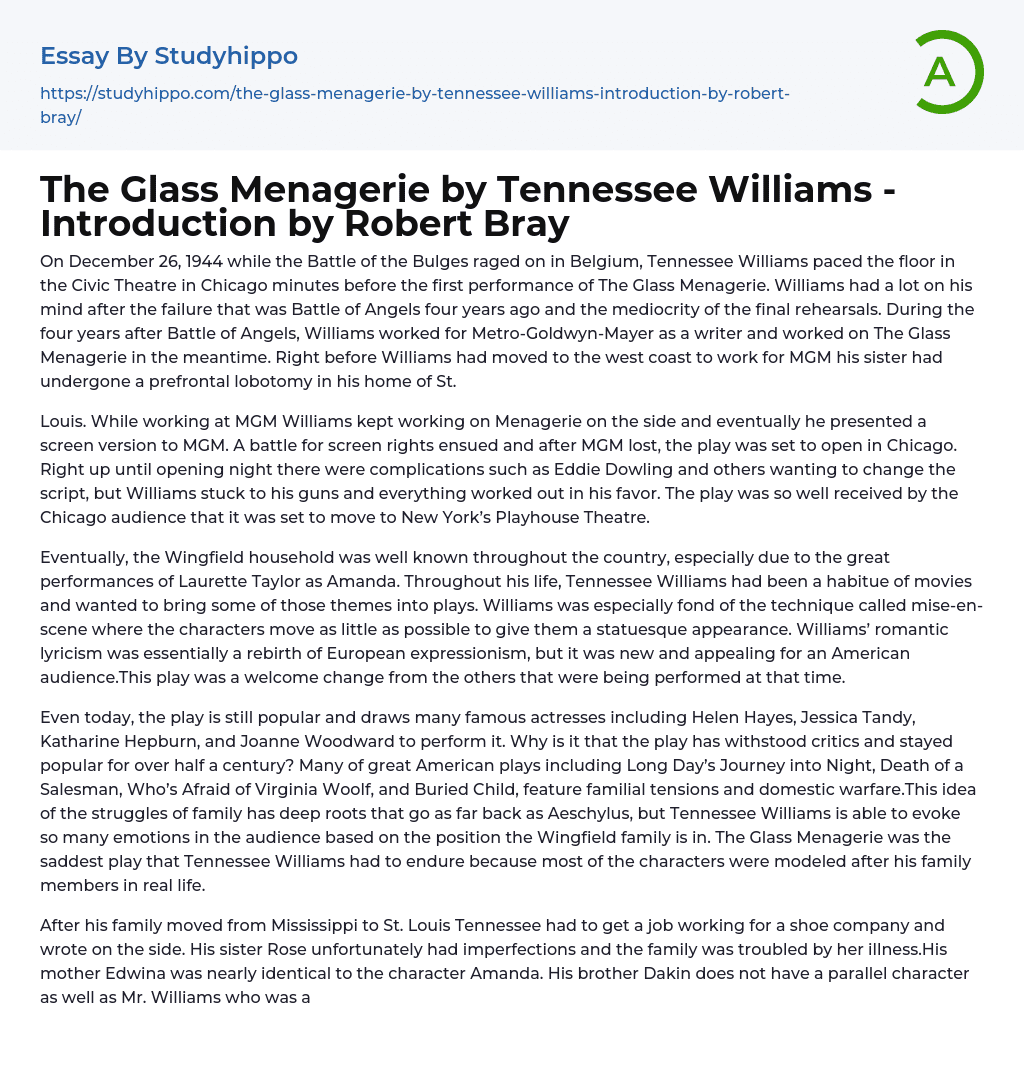

The Glass Menagerie by Tennessee Williams – Introduction by Robert Bray Essay Example
On December 26, 1944, Tennessee Williams anxiously paced the floor of Chicago's Civic Theatre as the Battle of the Bulges raged in Belgium. The opening performance of The Glass Menagerie was just moments away, and he had a lot on his mind. After experiencing failure with Battle of Angels four years prior and finding the final rehearsals of The Glass Menagerie mediocre, Williams worked for Metro-Goldwyn-Mayer as a writer before dedicating himself to writing this play. In addition to that, shortly before moving to work for MGM on the west coast, his sister underwent prefrontal lobotomy in their hometown of St.
During his time at MGM, Williams devoted his spare time to working on Menagerie. He later submitted a film version of the play to the studio, but a dispute over screen rights ensued and MGM lost out. Meanwhile, in Chicago, where the play was scheduled to debut, there were objecti
...ons from figures such as Eddie Dowling who wanted to make changes to the script prior to opening night. Despite facing opposition, Williams persevered and was ultimately successful; his efforts paid off when Menagerie received an overwhelmingly positive response from Chicago audiences and was subsequently selected for showing at New York's Playhouse Theatre.
The Wingfield household gained nationwide fame, largely due to Laurette Taylor's outstanding portrayal of Amanda. Tennessee Williams was a frequent moviegoer who sought to integrate cinematic elements into his plays. He admired the technique of mise-en-scene, which involved limited character movement for a more statuesque effect. Williams' romantic style drew inspiration from European expressionism but was refreshing and captivating for American audiences. This play was a welcome deviation from the norm during that time.
The
Glass Menagerie is a timeless play that remains popular and attracts renowned actresses, such as Helen Hayes, Jessica Tandy, Katharine Hepburn, and Joanne Woodward. Its enduring appeal is due to its portrayal of familial tensions and domestic conflict - themes common in many great American plays like Long Day’s Journey into Night, Death of a Salesman, Who’s Afraid of Virginia Woolf?, and Buried Child. This concept of family struggles has been prevalent since ancient times with roots traced back to Aeschylus. Tennessee Williams' depiction of the Wingfield family in The Glass Menagerie evokes various emotions from audiences. It's worth noting that the play held special significance for Williams as he based most characters on his own family members.
When Tennessee's family relocated from Mississippi to St. Louis, he had to work in a shoe company to make ends meet while pursuing his writing on the side. Unfortunately, his sister Rose suffered from an illness that troubled the family deeply. Tennessee's mother Edwina closely resembled the character Amanda, but his brother Dakin and Mr. Williams had no equivalent counterparts.
Tennessee Williams created a character in his play reminiscent of a gentleman caller he brought home for his sister. The three characters in the play face a tough situation, each struggling with their inner demons and trying to hide their problems to prevent the family from collapsing further. As the play progresses, Tom faces a difficult decision - either pursue personal freedom like his father or sacrifice himself for his mother and sister. Though leaving his sister will haunt him, Tom decides to free himself and pursue his dreams, embodying the "fugitive kind" character common in
Williams' writing.
Amanda reminisces about a time when numerous gentleman callers would visit her, but now she cannot live in the present. Her memories of summer days in the south, adorned in beautiful dresses surrounded by jonquils, keep her longing for the past and distant from her current situation in St. Louis. Although Amanda shares these tales to lift her daughter's spirits, she understands that finding a mate for Laura is unlikely.
It is challenging to discern whether Amanda genuinely desires what is best for her children or if she attempts to maintain their proximity to herself. Her controlling tendencies may cloud the situation. Additionally, Laura, with her physical imperfections and timidity, bears resemblance to the delicate creatures displayed on her shelf. As a result, she struggles to navigate the outside world. Jim O’Connor, a former high school star, has not accomplished much in his life since that time.
Despite barely making more than Tom currently, he still remains hopeful for his future. Jim and Laura's time together is important to her, and when the unicorn's horn breaks, it feels like a curse has been lifted. Laura mistakenly believes she can find a partner after their kiss, but her hope shatters when she learns about Betty. Unfortunately, Jim doesn't realize the impact he's had and leaves soon after.
Despite being a quiet play, Tennessee Williams' skillful ability to generate emotional scenes out of nothing makes this play highly exceptional and still popular even today. The characters' cries of despair are heard from the silence in the play, as Williams portrays it.
- Playwright essays
- Scotland essays
- Tennessee williams essays
- Theatre Of The Absurd essays
- A Doll's House essays
- A Midsummer Night's Dream essays
- A raisin in the sun essays
- A Streetcar Named Desire essays
- An Inspector Calls essays
- Death of a salesman essays
- Everyman essays
- Fences essays
- Hamlet essays
- Hedda Gabler essays
- Iago essays
- King Lear essays
- Macbeth essays
- Much ado about nothing essays
- Oedipus Rex essays
- Oedipus The King essays
- Othello essays
- Pygmalion essays
- Romeo And Juliet essays
- Tartuffe essays
- The glass menagerie essays
- The Importance of Being Earnest essays
- The Merchant Of Venice essays
- The Taming of The Shrew essays
- Twelfth Night essays
- Waiting For Godot essays



